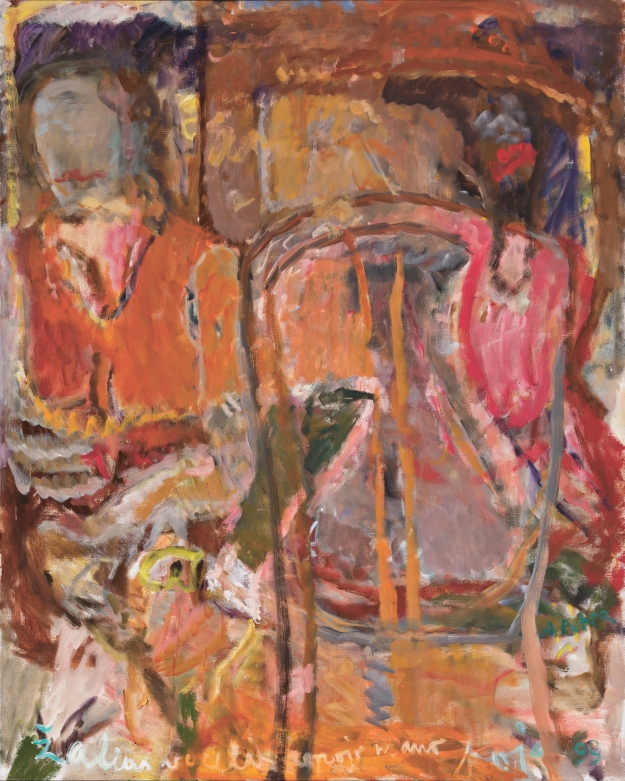Women, a cat and a green spider
Only a long and slow contemplation will help to unlock Audronė Petrašiūnaitė’s (b. 1954) painting Woman and a Cat. First, I start following the traces of the artist’s brush that rampaged through the surface of the canvas. Then I take a great while to decipher the inscription at the bottom of the canvas. To no avail. And only colourful brushstrokes wavering at the top of the painting look mildly comforting. After getting used to hundreds of colours and a seemingly fluttering image I start discerning the interior of a rural farmhouse with two sitting figures – a woman and a cat. Old acquaintances!
UždarytiFor almost twenty years they have been traveling from painting to painting. The key characters in Petrašiūnaitė’s paintings have always been a woman (often the painter herself), her beloved cats, houseplants, woven striped floor rugs and glasses of red wine. She used to paint the idyll of a quiet and full home which the viewer never tired of, spoke of the miracle of life, the immaculate and peaceful world of ‘my person’or, to be more exact, a woman’s world in the microcosm of her own home.
Woman and a Catis one of the last works from this long period in the artist’s creative life. After that the topics and the touch of the artist changed drastically. According to the author, this painting was ‘the turning point in saying goodbye to Bonnard-like painting’. Petrašiūnaitė truly liked Pierre Bonnard’s painting, just like she likes the works of Lithuanian modernists Viktoras Vizgirda, Antanas Samuolis or Vladas Eidukevičius. Today her paintings look different: they are more painful and expressive, but in no way dismal or destructive. Her bright and mysterious world full of home spirits lies dormant in the past. There was a sudden turning point in Petrašiūnaitė’s artwork, but again she has a lot to tell her viewers.
‘For me the important thing is the being of a person, the dialogue between the animate and inanimate nature when the dividing line between human existence and a pitch-black ploughed field disappears, when autumn is both around and inside you. When you look in the mirror and the mirror looks in you.’
Meanwhile, the painting by Petrašiūnaitė created almost 18 years ago includes all the most important characters: a woman, a cat, a chair, a mirror and a forest outside her window. Yes, in this painting they all live together and get along well. They are whispering something to each other in the brownish silence of the painting lit by evening dusk. The subtle nature of Petrašiūnaitė’s paintings stems from her sense of the wholeness of the world. Here is what the artist says: ‘For me the important thing is the being of a person, the dialogue between the animate and inanimate nature when the dividing line between human existence and a pitch-black ploughed field disappears, when autumn is both around and inside you. When you look in the mirror and the mirror looks in you.’ The chamber image of the ideal world portrayed in the painting Woman and a Cat is free from rush or noise and full of dreams, contemplation of a strand of sunshine or a shadow on the floor, and cat purring at your feet.
In this painting the artist portrayed a small room with two women sitting there. The woman on the left is pudgy and sturdy, but the painter left her without clear facial features. Her arms are down. It must be sad to have no face. The woman on the right is hardly noticeable. She has almost melted in the sea of colour and shades and turned into a background, although, according to the artist, she is supposed to be in the foreground. But the foreground and the main role in the painting belong to a fat, big-headed cat, the most beautiful cat of all cats that have ever been painted. It is half-hidden under a chair with its tail upturned and its triangular head turned sprightly towards us. Its eyes are of different colours. One of them is literally glowing. The painter highlighted it with a thick yellow contour. In general, the pet was painted with love, pleasant swing and energy.
Yet another interesting element of the painting is the inscription at the bottom of the painting saying: ‘A green spider was crawling up my leg.’Is this a joke? The artist remembers that the year when this painting was created she drew a lot and her sketchbook included a lot of drawings with text in them. So what? ‘One sentence accidentally ended up in the painting –this is of no importance,’Petrašiūnaitė says. To my mind, the phrase is important in that it bears witness to the authentic personality of the artist and her immaculate and almost childish frankness that pierces this painting and her entire artwork in general.


